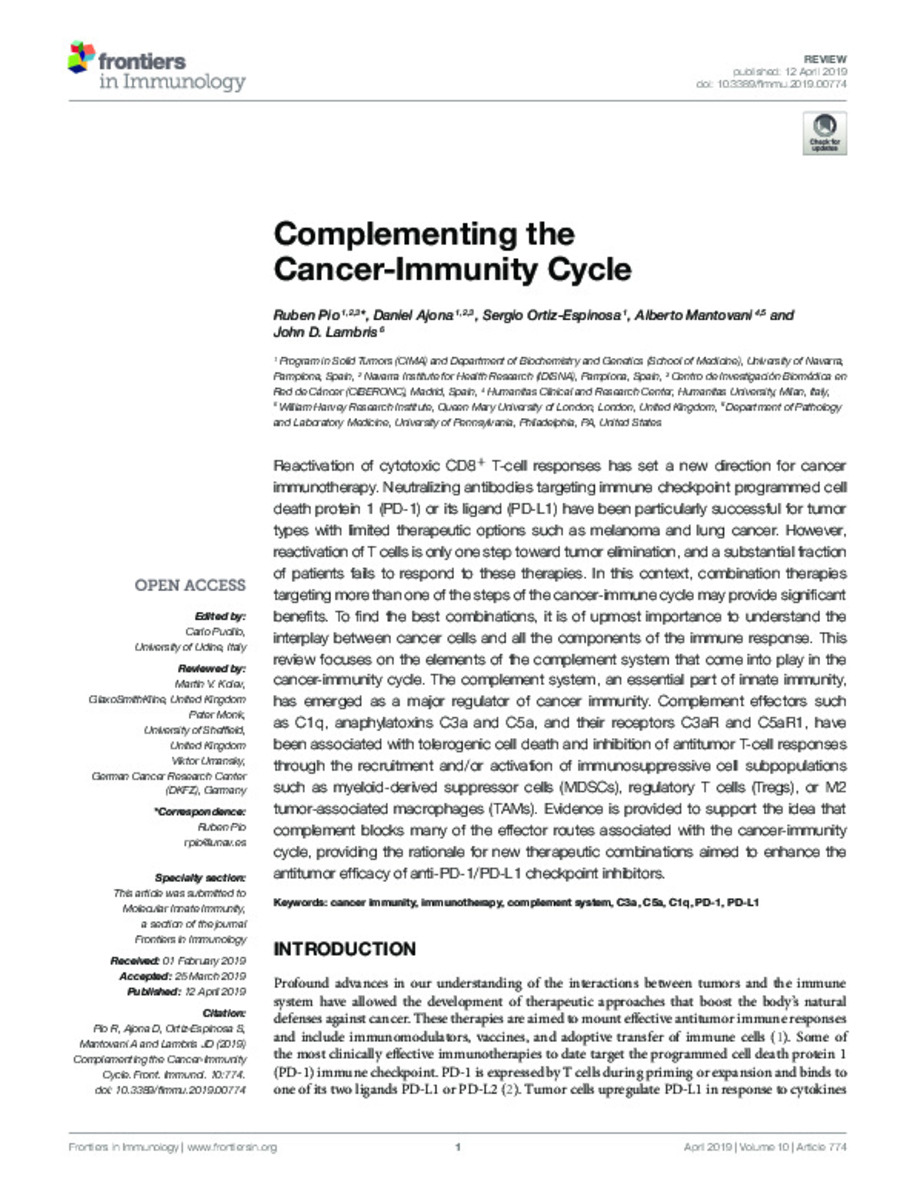Full metadata record
| DC Field | Value | Language |
|---|---|---|
| dc.creator | Pio, R. (Rubén) | - |
| dc.creator | Ajona, D. (Daniel) | - |
| dc.creator | Ortiz-Espinosa, S. (Sergio) | - |
| dc.creator | Mantovani, A. (Alberto) | - |
| dc.creator | Lambris, J.D. (John D.) | - |
| dc.date.accessioned | 2021-11-04T08:31:24Z | - |
| dc.date.available | 2021-11-04T08:31:24Z | - |
| dc.date.issued | 2019 | - |
| dc.identifier.citation | Pio, R. (Rubén); Ajona, D. (Daniel); Ortiz-Espinosa, S. (Sergio); et al. "Complementing the cancer-immunity cycle". Frontiers in Immunology. 10, 2019, 774 | es_ES |
| dc.identifier.issn | 1664-3224 | - |
| dc.identifier.uri | https://hdl.handle.net/10171/62315 | - |
| dc.description.abstract | Reactivation of cytotoxic CD8+ T-cell responses has set a new direction for cancer immunotherapy. Neutralizing antibodies targeting immune checkpoint programmed cell death protein 1 (PD-1) or its ligand (PD-L1) have been particularly successful for tumor types with limited therapeutic options such as melanoma and lung cancer. However, reactivation of T cells is only one step toward tumor elimination, and a substantial fraction of patients fails to respond to these therapies. In this context, combination therapies targeting more than one of the steps of the cancer-immune cycle may provide significant benefits. To find the best combinations, it is of upmost importance to understand the interplay between cancer cells and all the components of the immune response. This review focuses on the elements of the complement system that come into play in the cancer-immunity cycle. The complement system, an essential part of innate immunity, has emerged as a major regulator of cancer immunity. Complement effectors such as C1q, anaphylatoxins C3a and C5a, and their receptors C3aR and C5aR1, have been associated with tolerogenic cell death and inhibition of antitumor T-cell responses through the recruitment and/or activation of immunosuppressive cell subpopulations such as myeloid-derived suppressor cells (MDSCs), regulatory T cells (Tregs), or M2 tumor-associated macrophages (TAMs). Evidence is provided to support the idea that complement blocks many of the effector routes associated with the cancer-immunity cycle, providing the rationale for new therapeutic combinations aimed to enhance the antitumor efficacy of anti-PD-1/PD-L1 checkpoint inhibitors. | es_ES |
| dc.description.sponsorship | Authors’ research was supported by FIMA, CIBERONC, Fundación Científica de la Asociación Española Contra el Cáncer, Fundación Ramón Areces, Juan Serrano and Fondo de Investigación Sanitaria-Fondo Europeo de Desarrollo Regional Una manera de hacer Europa (PI17/00411) to RP and DA; U.S. National Institutes of Health (AI068730 and AI030040) to JL; AIRC IG, AIRC 5x1000, and Ministero della Salute to AM. SO-E was supported from fellowships from Amigos de la Universidad de Navarra and Formación de Personal Universitario (FPU 17/00032). | es_ES |
| dc.language.iso | eng | es_ES |
| dc.publisher | Frontiers Media SA | es_ES |
| dc.relation | info:eu-repo/grantAgreement/NIH/NATIONAL_INSTITUTE_OF_ALLERGY_AND_INFECTIOUS_DISEASES/N01AI030040-002/US | - |
| dc.relation | info:eu-repo/grantAgreement/NIH/NATIONAL_INSTITUTE_OF_ALLERGY_AND_INFECTIOUS_DISEASES/5P01AI068730-07/US | - |
| dc.rights | info:eu-repo/semantics/openAccess | es_ES |
| dc.subject | Cancer immunity | es_ES |
| dc.subject | Immunotherapy | es_ES |
| dc.subject | Complement system | es_ES |
| dc.subject | C3a | es_ES |
| dc.subject | C5a | es_ES |
| dc.subject | C1q | es_ES |
| dc.subject | PD-1 | es_ES |
| dc.subject | PD-L1 | es_ES |
| dc.title | Complementing the cancer-immunity cycle | es_ES |
| dc.type | info:eu-repo/semantics/article | es_ES |
| dc.description.note | This is an open-access article distributed under the terms of the Creative Commons Attribution License (CC BY) | es_ES |
| dc.identifier.doi | 10.3389/fimmu.2019.00774 | - |
| dadun.citation.publicationName | Frontiers in Immunology | es_ES |
| dadun.citation.startingPage | 774 | es_ES |
| dadun.citation.volume | 10 | es_ES |
Files in This Item:
Statistics and impact
Items in Dadun are protected by copyright, with all rights reserved, unless otherwise indicated.






